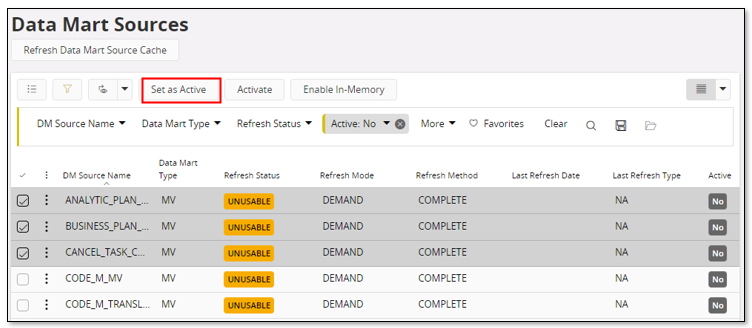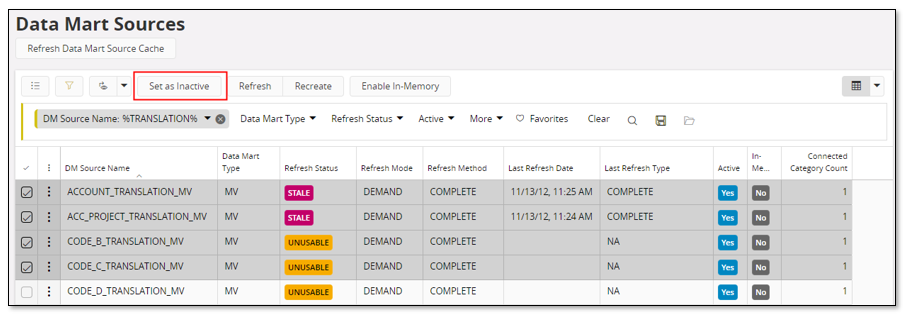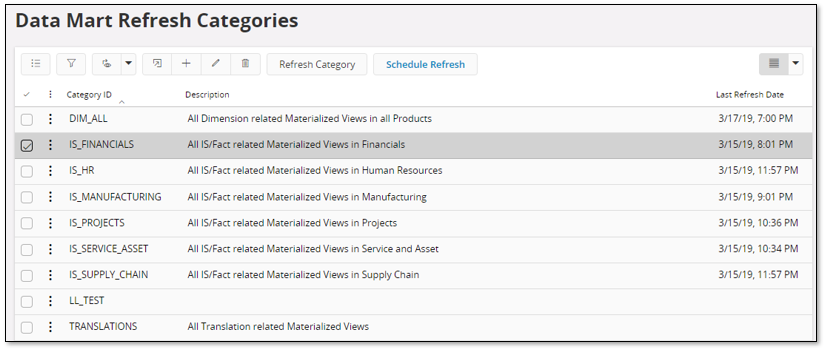Special Data Mart Source Related Subjects¶
This page supplies some information about special subjects related to administration of Data Mart sources.
For more general administration information please refer to Manage Data Mart Sources.
Refresh Data Mart Source Cache¶
After an installation/upgrade the Data Mart Sources page will in most cases show available Data Mart sources. If installation contains Data Mart sources but the page is empty or does not show accurate information, it is necessary to update the Data Mart Source Cache.
The refresh is handled by using the command Refresh Data Mart Source Cache in the Data Mart Sources page.

Set Data Mart Sources as Active¶
During installation all Materialized Views are created with the BUILD DEFERRED clause. Therefore, Materialized Views are not populated with data during the installation. The same goes for incrementally loaded tables, that will be empty until activated.
The state of installed Data Mart sources will by default be UNUSABLE.
The standard approach to get started with Data Mart sources is:
- Activate Data Mart sources with state UNUSABLE, i.e. create the first snapshot. The activation will only consider Data Mart sources with state UNUSABLE (that are not active.)
- Set up a scheduled job to perform repeated refresh of the activated Data Mart sources. It is also possible to manually refresh a Data Mart source. The refresh mechanism will not consider UNUSABLE Data Mart sources.
A Data Mart source can however be set as being Active. This option is available for a Data Mart source in any state. An Active Data Mart source is considered to be refreshed regardless of state (however a source in state FRESH is never refreshed).
More about Active Data Mart sources:
- An Active Data Mart source does not have to be activated separately
- Each refresh request will try to refresh the Data Mart source
- If the state of a Data Mart source goes from state FRESH / STALE to UNUSABLE, a scheduled refresh job will still refresh this Data Mart source since it is defined as being Active.
- One reason for this state transition can be due to environmental issues in e.g. an Oracle RAC environment. This case applies to Materialized Views only.
- Another reason is when a new version of a Materialized View is deployed. In this case the state/staleness will always be UNUSABLE. But if this Materialized View is part of an active scheduled task it will still be refreshed the next time the task is executed. This case applies to Materialized Views only.
Setting Data Mart sources as Active is handled by using the command Set as Active in the Data Mart Sources page.

Figure 1: Set selected Data Mart sources as Active
Note: The command will not refresh the Data Mart sources (populate it with data), it will only specify that the Data Mart sources should be regarded as Active
Activate Data Mart Sources¶
If a Data Mart source has the refresh status UNUSABLE and is not active, it means that the Data Mart source needs to be activated before it can be used. Activating a Data Mart source leads to that the first snapshot is created, i.e. the Data Mart source will be populated with data representing the first snapshot.
Data Mart sources can be activated using the command Activate in the Data Mart Sources page.
Note: When a Data Mart source is activated it will be set as Active.

Figure 2: Activate selected Data Mart sources
Note: Activating all or a large number of Data Mart sources in a single step is not recommended since it might take a lot of time and require a lot of system resources.
Manual Refresh of Data Mart Sources¶
Manual refresh of Data Mart sources is typically performed if the dimensions and facts in use do not display up-to-date information and when manual management is preferred to scheduled management.
Manual Refresh of Data Mart sources is performed using the command Refresh in the Data Mart Sources page.
Note: This option can only be performed on Data Mart sources marked as Active

Figure 3: Refresh selected Data Mart sources
Scheduled Refresh of Data Mart Sources¶
The scheduling of Data Mart sources referenced by an Information Source is handled using pre-defined tasks.
It is important to define a schedule that fits the needs of the customer, for e.g.:
- Once a day, in the morning or at the end of the working day
- Twice a day, typically in the morning and during lunch break
Note: This option can only be performed on Data Mart source which are set as Active
Recreate Materialized Views¶
Note: This option is only available for the Data Mart source of type Materialized View.
In some situations it is not possible to activate or refresh a particular Materialized View, due to e.g. related source changes.
It is however possible to manually recreate an active Materialized View using the command Recreate in the Data Mart Sources page. The Materialized View is dropped in the database and then an attempt will be made to recreate it using the metadata of the original object in the database.
After recreating the Materialized View it will also be automatically activated, since it was Active before performing the recreate operation.

Figure 4: Recreate Materialized Views
Note: This option can only be performed on Active Data Mart sources of type Materialized View having refresh status STALE or UNKNOWN
Set Data Mart Sources as Inactive¶
Use this option to mark one or more Data Mart source as inactive, i.e. as non- Active.
Consequences:
- An non- Active Data Mart source cannot be manually refreshed
- An non- Active Data Mart source being part of a scheduled refresh job will not be considered
- Recreate command is not available (if source type is Materialized View)
Setting Data Mart sources as inactive (non- Active ) is performed using the command Set as Inactive in the Data Mart Sourcespage.

Figure 5: Set selected Data Mart sources as Inactive
Note: This operation will only specify that the Data Mart source should be regarded as non- Active, i.e. Inactive
Detail Page with Index Information¶
In the Data Mart Sources overview page, select one or more sources and then use the Go to details action to navigate to the detail page, Data Mart Source.
This page age that provides the following information:
- All details about a specific source.
- Index information
- The group Indexes lists all indexes created on the source, both those defined during development, indicated as System Defined and those defined by the customer, i.e. custom defined indexes.
- Primary Key index - System Defined.
- Unique indexes - either System Defined or custom defined.
- Ordinary indexes - either System Defined or custom defined.
- The group Index Columns lists the index columns for one selected index.
- The group Indexes lists all indexes created on the source, both those defined during development, indicated as System Defined and those defined by the customer, i.e. custom defined indexes.

Use Manage Indexes to navigate to the Custom Indexes for Dm Sources page where it is possible to create custom specific indexes tailored to support e.g. reporting based on Data Mart access.
Note: Indexes indicated as System Defined are either indexes defined during core development or indexes added during a customization project. Non-System Defined indexes are those created using the Custom Indexes for Dm Sources page in IFS Cloud Web.
Data Mart Refresh Categories¶
It is possible to add Data Mart sources into different refresh categories. Using refresh categories simplifies the Data Mart source refresh administration by enabling refresh of a group of Data Mart sources at a given time.
The page Data Mart Refresh Categoriesprovides an overview of available categories.

Figure 6: Data Mart Refresh Categories
Some possible options/commands:
- Details Use the standard detail navigation to view the category details, e.g. Data Mart sources connected to the refresh category. This detail can also be used to view refresh information related to the refresh category as well as the last refresh date and refresh state for each of the connected Data Mart sources.

Figure 7: Data Mart Refresh Category Details
Use the detail to:
- Manually **refresh** a set of Data Mart sources, i.e. the sources connected to the category.
- **Schedule** refresh of a set of Data Mart sources, i.e. the sources connected to the category.
- **Gather Statistics** during refresh This option enables Oracle to gather statistics for the related database objects during the refresh process. It is recommended to use this option to make sure that statistics are up-to-date after the refresh, avoiding unexpected decrease of performance.
Note: This option only applies to Materialized Views - In the Connected Data Mart Sources section - Refresh one or more Data Mart sources using the command Refresh DM Source - View the refresh categories a specific Data Mart source is connected to using the command View Connected Categories - Remove a Data Mart source from a refresh category via ordinary Delete - Set one or more non-active Data Mart sources as Active using the command Set as Active
- Add New Sources Starts an assistant that is used to add new data mart sources to the current refresh category.
- Refresh Category Supports manually refresh all the Data Mart sources connected to a specific refresh category
- Schedule Refresh Supplies the possibility to schedule refresh of Data Mart sources connected to a specific refresh category
Note: It is possible to add a Data Mart source to a refresh category even if it is referenced by other categories. The user will however be notified if a Data Mart source is added to more than one refresh category. Please find more information in the Information Source feature documentation.
Note: The main purpose of this feature is to support scheduled refresh of a number of Data Mart sources. All Active Data Mart sources will be refreshed regardless of state/staleness.
It is also possible to use this feature to activate a number of Data Mart sources. First make sure that all in the category included Data Mart sources are marked as Active. Then a one-time job can be scheduled that will take care of the activation.
Pre-Defined Refresh Categories¶
It is recommended to add Materialized Views belonging to a component to pre-defined refresh categories.
Please refer to Storage Layer Development and to the Data Mart Source Refresh Recommendations page.
Exploring Referenced Data Mart Entities¶
Data Mart sources can be explored using a Data Mart entity, e.g. a dimension or fact, as the starting point.
Use the Explore By Information Source page or the Explore By Dimension page. For one specific entity it is possible to see all Data Mart sources referenced by the entity.
In the following example all Data Mart sources referenced by Information Source FACT_GL_BALANCE are listed.

Figure 8: Explore Data Mart sources based on Information Source
Note: The below listed command are made available depending on selected Data Mart sources.
The following (complete list of) commands are generally provided for a selected Data Mart source:
- Set as Active Sets selected non-active Data Mart sources as being Active
- Activate Activates, creates first snapshot of, selected Data Mart sources if not active and refresh status is UNUSABLE
- Refresh Refresh data in the selected Data Mart sources
- Set as Inactive Sets selected Data Mart sources as inactive, e.g. non- Active
-
In-Memory options
- Enable In-Memory
- Disable In-Memory
- Remove Analytical indexesNote: The idea is to remove analytical indexes to improve In-Memory access. This options should be used with care. The action is not reversible, i.e. once the indexes are removed they can not be added from the IFS client. All removed indexes will however be logged and can thus be added manually by a DB administrator (please refer to general documentation about In-Memory in IFS Cloud).
These options are only available in Oracle Enterprise Edition with In-memory option. - View Connected Categories Displays all refresh categories that one specific Data Mart sources is connected to.
There is also one global command:
- Refresh Data Mart Source Cache Will find all used Data Mart sources and update the Data Mart Source Cache.
Data Mart Source Refresh Recommendations¶
Read more about general recommendations related to refresh of Data Mart sources here.